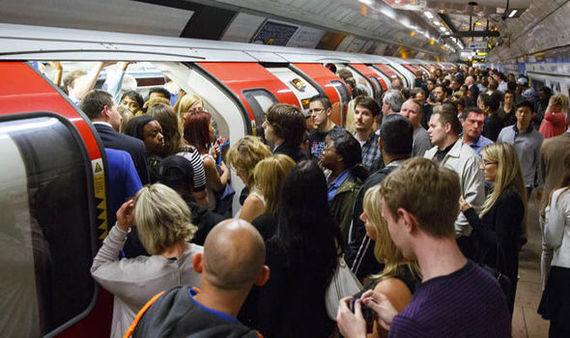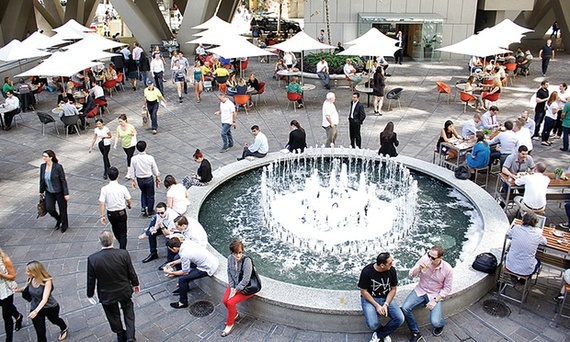Most of us have been taught that in order to make money and succeed we have to work hard, be serious, focused and professional. We have created work environments to reinforce these messages, where people work long days, don't move away from their desks, always trying to show how hard they are working, in order to feel valued.
The average employee spends two days a week in meetings, half of which are perceived to be a waste of time. Whilst we want to be a part of a community, we do not engage with others at work in meaningful ways, we suppress our emotions and struggle to overcome stress related illnesses, whilst making sure everyone thinks 'we are fine' and coping. Any attempt at having fun, relaxing and recharging is often seen as a distraction, discouraged and frowned upon as wasting productive company time.
As if all that wasn't bad enough, the majority of people have to endure long and tedious commutes in overcrowded public transport, to make sure they go in to the office, to show everyone how hard they are working, even though technology enables them to work from anywhere. One of the usual arguments against offering people greater autonomy over where and how they work is a lack of control and consequent lack of effort from employees. New evidence by the German Institute for Economic Research, suggests that what actually happens is the opposite. When employers relinquish control, people actually work more. People who enjoy autonomy on average put in an extra seven hours each week and are more committed to their employer as well as feel they are more connected to their family and community.
Changing business structures to leverage work de- localization, to generate diversified multi-centers, in which co working spaces become neighborhood services, thus reducing commute times and car usage can improve both the work life balance of millions of people but also improve local communities and the growth of local economies. Corporations are starting to embrace this by using co working spaces close to where people live to cut down commute times, access innovative talent through the co working ecosystem and also benefit from 'space-less growth' - maximizing flexibility while minimizing fixed costs.
These new working models are changing the workplace from a static container of routine work into a hub for bringing colleagues together. The office has become a 'high-tech coffee shop', where networked individuals meet, share, collaborate and develop ideas, strategies and solutions. A place used more intermittently and intensively, designed with meaning, focused on values, culture, community.
The office begins to look and work more like a city - drawing to itself valued urban experiences and spaces: quiet areas, individual experiences, courtyards, cafes, social destinations and serendipitous encounters. The successful characteristics of cities become part of the design language; permeability, diversity, overlapping experiences that surprise, delight and constantly change. Space no longer reflects hierarchical structures but supports dispersed networks and open source innovation.
The nature of the city also changes as it becomes an extension of the office - a broad workscape in which key work functions move into parks, coffee shops and co-working spaces. Learning from successful cities, urban places that are more flexible and offer people opportunities to network, learn and create together, are also more able to adapt to short and long-term economic, social and environmental changes. These lessons can also be applied to future-proof offices. As such the workplace should increasingly be designed and managed less as a static backdrop to routine solitary work, and more as a 'flexible', 'hotel-style' facility that provides a high level of service and experience to its demanding 'guests'.
We now have four generations at work and they are all aligned on their expectations of: choice and flexibility, greater transparency, more teamwork and more amenities to support authentic sociability, knowledge, convenience and wellbeing.
Healthy employees are significant factors to a healthy bottom line but our entire approach to workplace requires transformation. Our current wellbeing paradigm is stuck measuring the cost of various degrees of illness rather than calculating the value of higher levels of wellness and proactively enabling people to thrive. Happiness and wellbeing are good for business. Happier and healthy employees are more productive.
The British Council of Offices's 2014 research 'Making the Business Case for Wellbeing', states that more than a third of participants accuse their employer of not valuing their well-being at all. The report comes up with three areas to help employers create a culture of wellbeing: care; control and collaboration: The study found that nine out of ten workers, feel their well-being diminishes if they don't have control over their day-to-day activities. In addition, they want the flexibility and control to mix collaboration with colleagues with quiet moments of concentration to help them get 'in the zone'. Nine out of ten workers claim, that working 'in the zone' helps them perform better as well as feel better. However, currently over three quarters of people feel they are hampered by a noisy open-plan environment and more than two thirds would like to see relaxation areas in their workplace to recharge. Companies can meet this need for control by offering employees flexibility and choice of how and where they work and trusting them to decide their own working patterns. However, building a collaborative environment as flexible and remote working grows means companies need to embrace connectivity to ensure that employees have the tools to work, discuss and innovate together no matter where they are.
It is easy to see how real estate portfolios will increasingly become a dispersed network of workplaces; social and adaptive working environments, empowering users and teams across different work contexts and collaboration modes. Our own workplace will be a menu of co working environments that leverage our social networks and support our personal needs and aspirations day to day-- hour by hour.
Real estate needs to become a service industry focused on people, rather than on assets and the design and management of buildings should be less about the 'hardware' of work - desks, partitions, technology, electricity, and so on; and much more about the 'software' of work - the cultural, social and value systems of the organisations.
Focus on the 'aspirational' aspects of the workplace: empowering workers to do their best work with space, amenities & services that revitalise and events to stimulate growth for individuals and businesses.
Related
Sign up for Peacock to stream NBCU shows.
to stream NBCU shows.


